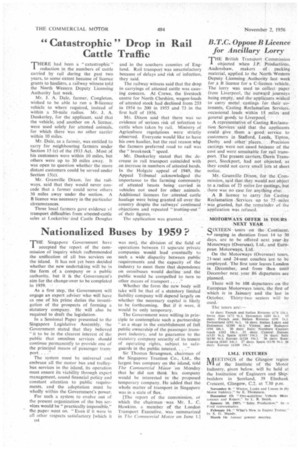" Catastrophic " Drop in Rail Cattle Traffic
Page 44

If you've noticed an error in this article please click here to report it so we can fix it.
PERE had been a " catastrophic " reduction in the numbers of cattle carried by rail during the past two years, to some extent because of licence grants to hauliers. a railway witness told the North Western Deputy Licensing Authority last week.
Mr. J. A. Dale, farmer. Congleton. wished to be able to run a B-licence vehicle to where required, instead of within a 50-mile radius. Mr. J. A. Dunkerley, for the applicant, said that the vehicle, and another on A licence, were used solely for attested animals, for which there was no other carrier within 10 miles.
Mr. Dale, as a farmer, was entitled to carry for neighbouring farmers under Section 15(c) of the 1933 Act. Most of his customers were within 10 miles, but others were up to 30 miles away. It was open to question whether the more distant customers could be served under Section 15(c).
Mr. Granville Dixon. for the railways, said that they would never concede that a farmer could serve others 30 miles away under the section. A B licence was necessary in the particular circumstances.
Three local farmers gave evidence of transport difficulties from attested-cattle sales at Lockerbie and Castle Douglas and in the southern counties of England. Rail transport was unsatisfactory because of delays and risk of infection, they said.
The railway witness said that the drop in carryings of attested cattle was causing concern. At Crewe, the livestock centre for North Cheshire, wagon-loads of attestedstock had declined from 253 in 1954 to 200 in 1955 and 73 in the first half of 1956.
Mr. Dixon said that there was no evidence of serious risk of infection to cattle when taken by rail. Ministry of Agriculture regulations were strictly observed. Everyone would like to have his own haulier, but the real reason why the farmers preferred road to rail was the " breakneck" speed.
Mr. Dunkerley stated that the decrease in rail transport coincided with an increase in numbers of attested herds. In the Holgatc appeal of 1949, the Appeal Tribunal acknowledged the importance to the farming community of attested beasts tieing carried in vehicles not used for other animals. Additional licences for attested cattle haulage were being granted all over the country despite the railways' continued objections and repeated "trotting-out " of their figures.
The application was granted.
















































































































